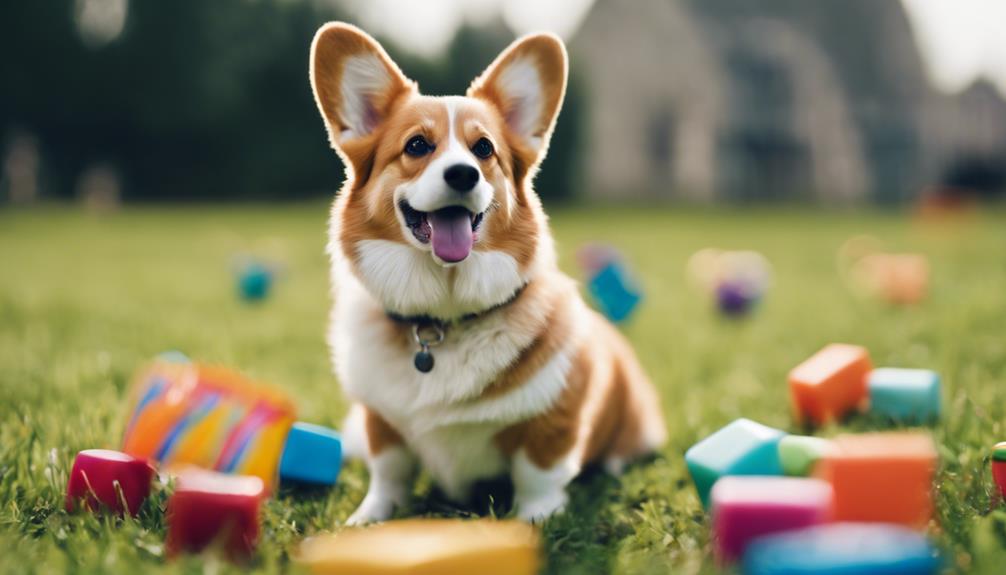Training a new rescue dog presents unique challenges and opportunities that require a thoughtful approach. Establishing a consistent routine, employing positive reinforcement, and understanding the specific behaviors of your dog are critical for success. It is equally important to recognize the nuances of their past experiences and how these may influence their responses to training. As you embark on this journey, consider the pivotal role of socialization and its impact on your dog's adaptability. The subsequent strategies for addressing common challenges may prove essential in ensuring a harmonious integration into your home.
Understanding Corgi Behavior

Understanding a Corgi's behavior is essential for fostering a strong bond and ensuring effective training for your new rescue dog.
Corgis are known for their unique breed characteristics and corgi quirks, which can influence their interactions and learning style. These small, energetic dogs often display a playful demeanor, coupled with a strong herding instinct. This means they may chase after moving objects or even people, which can lead to mischief if not managed properly.
Corgis also tend to be quite vocal, expressing themselves through barks and yips. Additionally, they are intelligent and can quickly learn commands, but they may also exhibit stubbornness.
Understanding these traits will help you tailor your training approach, making it more enjoyable for both you and your Corgi.
Establishing a Routine
Establishing a routine for your new rescue dog is crucial for their adjustment and well-being.
Consistency in daily activities, such as feeding, walking, and training, helps your dog understand what to expect, reducing anxiety and promoting good behavior.
A structured daily schedule not only fosters a sense of security but also strengthens the bond between you and your furry friend.
Importance of Consistency
Maintaining a consistent routine is crucial for helping your new rescue dog feel secure and understand expectations. A structured training environment helps your dog learn more effectively.
For instance, setting specific times for feeding, walks, and training sessions creates predictability, which can be comforting. Additionally, utilizing reward systems consistently reinforces positive behavior. When your dog knows that good actions lead to rewards, such as treats or praise, they are more likely to repeat those behaviors.
This reliability not only enhances learning but also strengthens the bond between you and your pet. Remember, consistency in commands, rewards, and daily activities fosters a sense of security, making it easier for your rescue dog to adapt to their new home.
Daily Schedule Structure
A well-structured daily schedule not only reinforces the importance of consistency but also provides your rescue dog with a clear framework for activities, helping them acclimate to their new environment.
Start by establishing regular meal times, as this creates a sense of security and helps regulate their digestion. Aim for two to three meals per day, depending on your dog's age and size.
Incorporate exercise breaks into your schedule, allowing for frequent walks and playtime. These breaks are vital for physical health and mental stimulation.
A suggested daily structure could include:
- Morning: Meal time followed by a walk
- Afternoon: Playtime and training exercises
This routine fosters a balanced lifestyle for your new companion.
Positive Reinforcement Techniques

Positive reinforcement techniques, which involve rewarding desired behaviors to encourage their repetition, are essential for effectively training your new rescue dog.
These methods help build a trusting bond between you and your dog, making the learning process enjoyable.
Utilizing clicker training and various reward systems can significantly enhance your training experience.
Consider these effective strategies:
- Use treats: Offer small, tasty rewards immediately after your dog performs the desired behavior.
- Incorporate toys: Use your dog's favorite toy as a reward during playtime.
- Praise and affection: Verbal praise and petting can reinforce positive actions.
Socialization With Other Dogs
Socialization with other dogs is essential for your new rescue dog's development and overall well-being.
Positive encounters can help build confidence and reduce anxiety, while controlled play dates provide a safe environment for interaction.
Positive Dog Encounters
Engaging your rescue dog in controlled encounters with other dogs is crucial for fostering healthy social behaviors and building confidence.
Positive dog experiences can reduce anxiety and promote good manners.
Here are some tips to ensure successful interactions:
- Start with dog parks that allow smaller groups.
- Opt for friendly introductions in neutral settings.
- Monitor body language for signs of stress or excitement.
Controlled Play Dates
Arranging controlled play dates with other dogs can significantly enhance your rescue dog's social skills and provide a safe environment for interaction.
To ensure a positive experience, focus on proper doggy introductions. Begin in a neutral space, allowing the dogs to sniff each other while maintaining leashes for safety.
During playtime, monitor their behavior closely to encourage playtime etiquette, such as sharing toys and taking breaks. If one dog shows signs of stress or aggression, intervene calmly and redirect their attention.
Gradually increase the duration of these play sessions, allowing your dog to build confidence and engage positively with others.
Consistent controlled play dates can lead to improved socialization, making your rescue dog a well-adjusted companion.
Basic Commands Training

Establishing a foundation of basic commands is crucial for fostering effective communication and building a strong bond with your new rescue dog.
Teaching these commands not only aids in training but also enhances safety for both the dog and its owner. Utilizing clicker training can be an effective method, as it reinforces positive behavior through consistent rewards. Pairing commands with clear vocal cues helps the dog understand what is expected.
Here are some essential commands to teach:
- Sit: A fundamental command that promotes calmness.
- Stay: Helps with impulse control and safety.
- Come: Vital for recall in various situations.
Addressing Common Challenges
Many new rescue dog owners encounter common challenges that can hinder the training process and the development of a trusting relationship with their pets.
Behavioral issues, such as anxiety or fear, often arise from the dog's past experiences. These issues can lead to training setbacks, making it difficult for both the owner and the dog to progress.
To address these challenges, consider the following tips:
- Identify triggers: Recognize situations that cause stress or fear in your dog.
- Gradual exposure: Slowly introduce your dog to these triggers in a controlled environment.
- Positive reinforcement: Reward desired behaviors to encourage progress.
Maintaining Consistency and Patience

Building a trusting relationship with your rescue dog requires maintaining consistency and patience throughout the training process.
Establishing clear behavioral expectations can significantly enhance your dog's learning experience. Remember, every dog learns at their own pace, so it's crucial to stick to a realistic training timeline.
- Be consistent with commands and cues.
- Reward positive behavior immediately.
- Practice regularly to reinforce learning.

